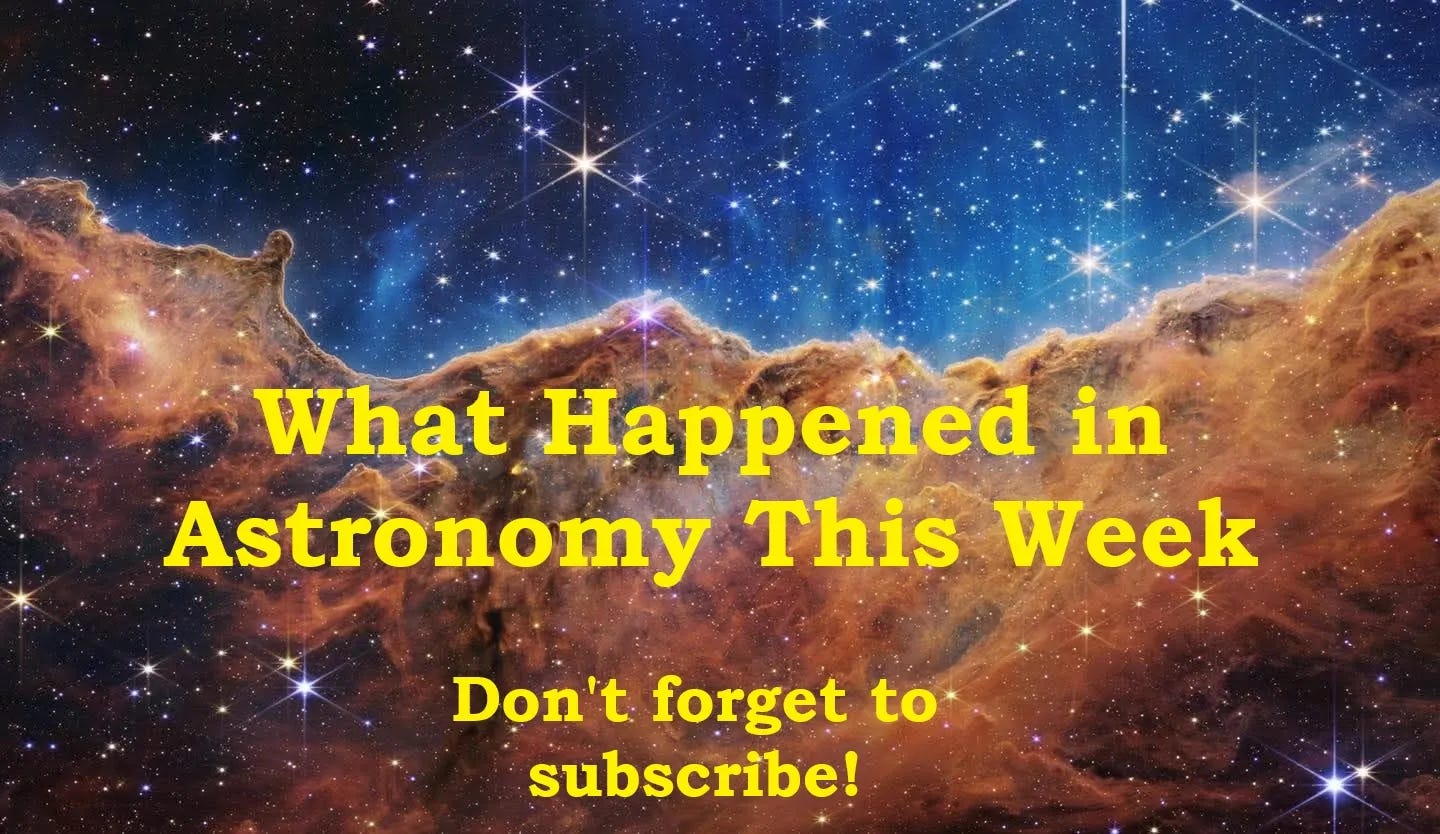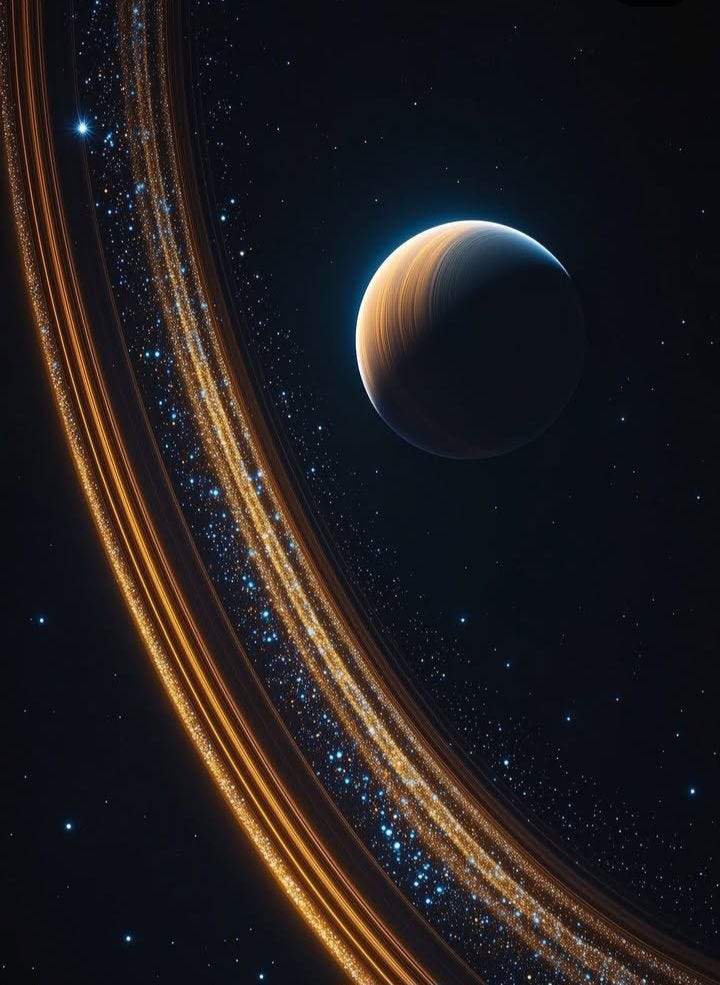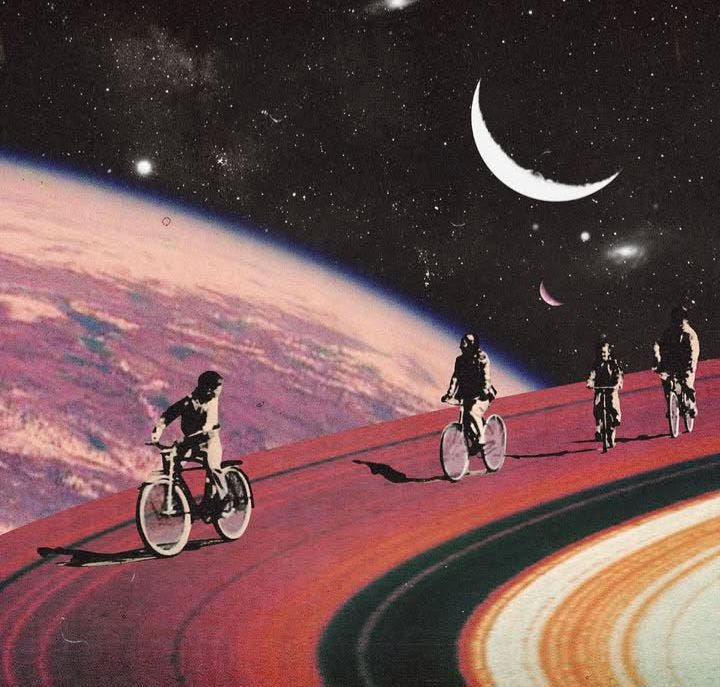Solar Storms, Ancient Comets, and Dying Stars: A Week of Cosmic Connections
What Happened This Week In Astronomy
EAUN (Everything Astronomy and the Universe Newsletter) is the official publication of:
Everything Astronomy and the Universe (Main page) Follow
Everything Astronomy and the Universe (main group) Join
Everything Astronomy and the Universe (satellite group) Join
Everything Science and the Universe Join
Quantum mechanics, Mathematics, Astrophysics, and Group of Physicists
Worldwide Amazing Space Events /Natural Phenomena/ Weather Events
Right Meme News, Updated Daily (the admins still can’t hear you scream)
The Discovery Plateau Hypothesis
About the Author
I, Eric Varney, am an independent professional, theorist, writer, creator of the Discovery Plateau Hypothesis, Transistors and Symphonies: Orchestrated Networks of Specialized Small Language Models as a Scalable Alternative to Monolithic LLMs, Liminal Spaces, Liminal Spaces: Primal Scream Therapy, and a member of the admin team at Everything Astronomy and the Universe. My work blends scientific inquiry and futurism Monday through Friday, and speculative fiction on Sundays.
If you like my work, consider sending a tip over Cash App to $ericvarney1
Related:
The dominant story for sky watchers across North America centers on remarkable solar activity that has brought auroras to unusually low latitudes. Between October 11 and 13, the Sun unleashed a series of coronal mass ejections—essentially massive eruptions of magnetized plasma from the solar corona—that have been traveling through interplanetary space toward Earth. These CMEs, described as arriving in a “train” formation, began interacting with Earth’s magnetosphere on October 16, triggering geomagnetic storm conditions that NOAA’s Space Weather Prediction Center classified as G2, or moderate intensity. This level of disturbance is significant enough to push auroral displays southward from their typical polar confinement, making the northern lights potentially visible from mid-latitude locations across the United States and southern Canada.
The timing of these storms illustrates one of the persistent challenges in space weather forecasting: while scientists can detect CMEs leaving the Sun and calculate their general trajectory toward Earth, the precise moment of impact and the resulting storm intensity depend on variables that remain difficult to predict with precision. The speed of the solar wind carrying the CME and the orientation of its embedded magnetic field relative to Earth’s own magnetic field determine whether the interaction will be a glancing blow or a direct hit, and whether it will efficiently transfer energy into our magnetosphere. For Thursday night into Friday morning, conditions appeared favorable for aurora viewing across much of the northern tier of states, provided observers had clear skies and minimal light pollution. The practical advice for anyone hoping to catch the display is straightforward: venture away from city lights, look toward the northern horizon after astronomical twilight ends, and watch for the characteristic green glow that marks oxygen atoms in the upper atmosphere being energized by incoming solar particles.
(Image: Universal Code)
This burst of solar activity is not an isolated anomaly but rather a continuation of Solar Cycle 25’s unexpectedly robust performance. Solar cycles follow an approximately eleven-year pattern of rising and falling activity, and the current cycle has proven more vigorous than some initial predictions suggested. This means that even if clouds or timing thwart observers this particular week, similar opportunities should recur in the coming months as the Sun maintains its active phase. The auroras represent one of the most accessible intersections between professional space physics and backyard sky watching—a phenomenon that can be tracked through satellite data and forecasting models while simultaneously being experienced as a direct visual spectacle.
Running parallel to the solar drama is the appearance of Comet C/2023 A6, discovered by the Mount Lemmon Survey on January 3, 2023. This icy visitor from the outer solar system has brightened dramatically as it approaches the inner solar system, reaching the threshold where observers with binoculars can easily locate it, and those blessed with truly dark rural skies might glimpse it with unaided eyes. The comet’s visibility peaks in mid-to-late October, with its closest approach to Earth occurring around October 21. For Northern Hemisphere observers, the window of opportunity comes in the western sky shortly after sunset, when the comet appears relatively low on the horizon before setting.
Through binoculars or telescopes, Comet Lemmon reveals the classic components of an active comet: a fuzzy coma—the cloud of gas and dust surrounding the nucleus—that observers report shows a subtle greenish tint, characteristic of diatomic carbon molecules fluorescing under solar ultraviolet light. Extending from the coma is a wispy tail, already photographed in striking detail by astrophotographers. One remarkable sequence even captured a disconnection event, where the solar wind literally severed a section of the tail, causing it to drift away as the comet regenerated a new tail behind it. These disconnection events remind us that comets are not merely passive snowballs reflecting sunlight but active participants in the space environment, continuously interacting with the solar wind and magnetic fields that permeate the solar system.
The comet’s brightness can fluctuate from night to night as jets of sublimating ice erupt from different locations on the rotating nucleus, and as the viewing geometry changes with the comet’s motion. What makes this particular comet especially noteworthy is its orbital period—estimated at roughly one thousand years. This means that the comet’s previous visit to the inner solar system occurred around the time of the Middle Ages, and its next return will not happen for another millennium. It represents a genuinely once-in-a-lifetime viewing opportunity, and for anyone with even a casual interest in astronomy, it’s worth making the effort to observe while conditions remain favorable.
Meanwhile, the James Webb Space Telescope continues to reshape our understanding of planetary systems and their ultimate fates. One study receiving attention this week focuses on GD 362, a white dwarf star surrounded by a debris disk. White dwarfs are the dense, cooling cores left behind after Sun-like stars exhaust their nuclear fuel and shed their outer layers. The debris disk around GD 362 consists of material from what were once planetary bodies—asteroids, rocky planets, or perhaps even planetary cores—that survived their star’s death throes only to be gravitationally torn apart and scattered into a disk as they ventured too close to the white dwarf’s intense gravity.
What makes JWST’s observations transformative is the telescope’s ability to analyze the chemical composition of this pulverized planetary material in unprecedented detail. By studying the infrared spectra of the disk, astronomers can inventory the elements present—oxygen, silicon, magnesium, iron, and potentially more volatile compounds—and reconstruct what these destroyed worlds were made of. This forensic astronomy provides crucial insights into how rocky planets form and differentiate, separating into core, mantle, and crust layers, and how much water and other volatiles they retain. Each white dwarf debris disk acts as a kind of core sample from a planetary system, offering a window into planetary compositions that would be nearly impossible to measure through other means. The results from GD 362 appeared in an October 8 arXiv preprint and are working their way toward peer-reviewed publication.
Another JWST investigation generating buzz involves WASP-39b, a previously known exoplanet now being scrutinized for possible evidence of an exomoon. The telescope’s spectroscopic observations have detected a cloud of gas associated with the planet that some researchers suggest could be explained by an extremely volcanically active moon, similar to Jupiter’s moon Io but even more extreme. Such a moon could be spewing gas into the space around its host planet, creating a detectable signature in the planet’s spectrum. However, the exomoon interpretation remains highly speculative and faces substantial skepticism from the broader astronomical community. Alternative explanations abound: the gas could arise from interactions between the planet and its host star, from complex photochemical reactions in the planet’s own atmosphere, or from atmospheric circulation patterns we haven’t fully modeled. Exomoons sit at the very edge of current detection capabilities, and confirming their existence requires ruling out numerous competing scenarios. Regardless of whether WASP-39b actually hosts a moon, the investigation demonstrates how JWST is pushing planetary science into new territory, attempting to detect not just planets but potentially their satellites as well.
JWST also produced a striking educational showcase this week in the form of a curated collection of gravitational lensing images. Gravitational lensing occurs when a massive foreground object—typically a galaxy or galaxy cluster—warps the fabric of spacetime sufficiently to bend the light from more distant background objects. The result is a spectacular array of visual distortions: distant galaxies stretched into arcs, duplicated into multiple images, or magnified into visibility that would otherwise be impossible. These images are not merely aesthetic curiosities but contain encoded information about the mass distribution of the lensing object, including the dark matter that dominates its gravitational field but emits no light. By carefully modeling the distortions, astronomers can map dark matter’s distribution and even use the most massive clusters as natural telescopes to study objects in the extremely distant universe that would be too faint to observe otherwise.
Some lensing systems have produced particularly dramatic results, such as lensed supernovae where the explosion’s light takes multiple paths through the gravitational field, arriving at Earth at different times. Supernova Requiem and Supernova Encore are examples where astronomers observed the same stellar explosion multiple times, separated by years, as light traveling along different gravitational paths arrived at different moments. This time-delay phenomenon allows precise measurements of cosmic expansion rates and tests of gravitational theory in extreme regimes.
The broader exoplanet field continues its rapid evolution, with the confirmed planet count now exceeding six thousand worlds. This milestone represents a complete transformation in humanity’s cosmic census over just three decades, from knowing only our own solar system’s planets to cataloging thousands of planetary systems across the galaxy. However, the field is shifting from simple detection to detailed characterization. Early exoplanet discoveries favored massive, hot planets orbiting close to their stars—the so-called hot Jupiters—simply because these were easiest to detect through transit and radial velocity methods. Modern surveys are pushing toward smaller, cooler planets, including rocky worlds in or near their stars’ habitable zones where liquid water could potentially exist on surfaces.
(Image: Universal Code)
The next generation of exoplanet science demands technique diversification beyond the transit and radial velocity methods that have dominated the field. Astrometry—measuring the tiny wobbles in a star’s position caused by orbiting planets—is becoming viable at the micro-arcsecond precision needed to detect Earth-mass planets around nearby stars. Direct imaging with advanced coronagraphs and proposed starshades could eventually allow telescopes to photograph rocky exoplanets as distinct points of light rather than indirect signatures. Perhaps most ambitiously, astronomers are developing methods to search for exomoons and even planetary rings, phenomena that would require detecting vanishingly subtle variations in transit signatures or dynamical interactions.
The ultimate goal extends beyond merely knowing that planets exist to understanding their atmospheres, climates, and surface conditions. Future observatories aim to probe atmospheric composition for biosignature gases—molecules like oxygen, methane, or phosphine in combinations that might indicate biological activity. This work requires extraordinary caution to avoid false positives from abiotic chemistry, but it represents the logical endpoint of the exoplanet revolution: determining not just where worlds exist, but where life might exist alongside them.
For practical observers, October offers an unusually rich menu of targets and events. The Orionid meteor shower, fed by debris from Halley’s Comet, reaches its peak in late October, with the best viewing coming in the pre-dawn hours when the shower’s radiant point in Orion rises high in the eastern sky. The Draconid meteor shower, while typically modest, occasionally produces unexpected bursts of activity depending on whether Earth passes through a fresh filament of debris from its parent comet. Combined with Comet Lemmon in the evening sky and the possibility of auroras during geomagnetic storms, October presents multiple reasons to spend time under dark skies.
An important meta-theme emerges from this week’s astronomy news: the intricate connections between phenomena at vastly different scales. The same solar wind that triggers auroras in Earth’s atmosphere also sculpts comet tails millions of miles away. The gravitational lensing that allows cosmologists to weigh dark matter in distant galaxy clusters also creates time delays that let us watch individual supernovae replay themselves across years. These connections reveal the cosmos as a deeply integrated system rather than a collection of isolated objects.
One story that captures this integration of scales involves the astronomical community in Hanle, Ladakh, India, where local residents are being trained as astronomy guides and educators. Located at a high altitude with exceptional sky darkness, Hanle has become both a research outpost—home to several professional observatories—and a destination for astrotourism. The development of local expertise and sustainable tourism infrastructure represents a crucial but often overlooked component of modern astronomy: preserving access to dark skies. As light pollution spreads globally, threatening astronomical research and severing humanity’s connection to the night sky, initiatives like Hanle’s demonstrate that dark sky preservation requires social and economic frameworks, not just technical solutions. Training local communities to value and share their night skies creates stakeholders for darkness itself, a natural resource increasingly under threat.
The week’s astronomy news may not have delivered a single revolutionary discovery, but collectively it illustrates how the field progresses: through accumulated observations, cross-linked phenomena, and the patient work of connecting solar physics to cometary dynamics to exoplanetary science to cosmological tests. For anyone with access to dark skies, the invitation is clear: monitor space weather forecasts for aurora opportunities, search the western twilight for Comet Lemmon while it remains visible, mark the calendar for the Orionids, and follow the ongoing analysis of JWST data as white dwarf debris disks and potential exomoons move toward firmer conclusions. Astronomy advances through both professional facilities pushing the boundaries of detection and individual observers maintaining their connection to the sky overhead—both necessary, both enriching the human understanding of our place in the cosmos.
Related:
Cosmic Chronicles: From Dust-Shrouded Giants to Antarctic Flybys
EAUN (Everything Astronomy and the Universe Newsletter) is the official publication of:
Recommended Reading:
Space Weather: Physics and Effects by Volker Bothmer & I. A. Daglis
Comet Science: The Study of Remnants from the Birth of the Solar System by Jacques Crovisier and Thérèse Encrenaz
Comet Hunters by David H. Levy
Exoplanets edited by Sara Seager
The Planet Factory by Elizabeth Tasker
Worlds Beyond: The Search for Habitable Planets by Chris Impey
Gravitational Lenses by Peter Schneider, Jürgen Ehlers, and Emilio Falco
NASA’s JWST public gallery
White Dwarfs: Cosmological and Galactic Probes by Enrico García
The End of Everything (Astrophysically Speaking) by Katie Mack
Turn Left at Orion by Guy Consolmagno and Dan M. Davis
The Backyard Astronomer’s Guide by Terence Dickinson & Alan Dyer
Sky & Telescope’s monthly “Sky at a Glance” section






